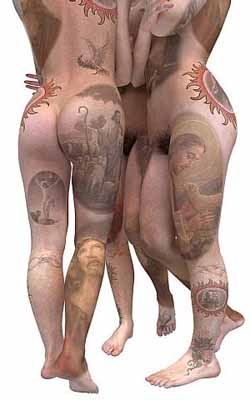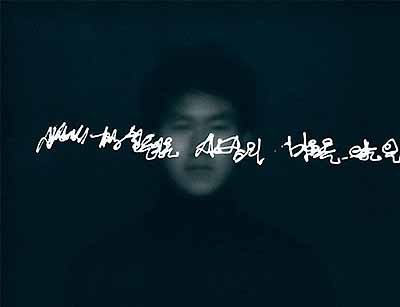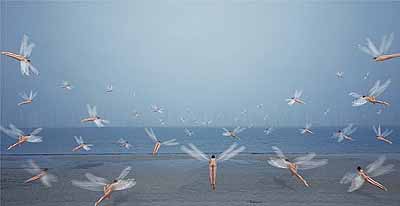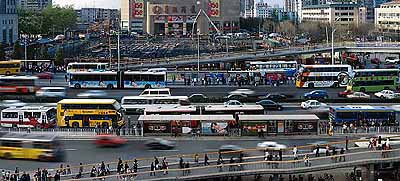
Asia: The Place to be
HAI Bo » Kyungwoo Chun » Kim Joon » CHI Peng » MIAO Xiaochun » & others
Exhibition: 27 Sep – 19 Nov 2005
Alexander Ochs Galleries Berlin I Beijing
Sophienstr. 21
10178 Berlin

ALEXANDER OCHS PRIVATE
Schillerstr. 15
10625 Berlin
+49 (0)30-45 086 878
ochs@alexanderochs-private.com
www.alexanderochs-private.com
Wed-Fri 13-18, Sat 11-15
Dreizehn Mal stellt sich in dieser Ausstellung die Frage ASIA: THE PLACE TO BE? Neun Künstler kommen aus China, drei aus Südkorea und mit Gerhard Richters Mao-Portrait von 1968 ist auch ein Vertreter des westlichen Blicks nach Osten präsent. Noch nie zeigte Alexander Ochs in einer seiner Galerien eine Darstellung Mao Dsedongs. Bei der ersten Ausstellung in den neuen Räumen fällt der Blick bereits vom Eingang aus auf das diffus aus dem Dunkel aufscheinende Gesicht des ‚großen Vorsitzenden’. Wie zwiespältig die Beziehung des heutigen China zum Gründer der Volksrepublik ist, zeigt die von der offiziellen Geschichtsschreibung proklamierte 70/30 Formel - d. h. 70 Prozent seiner Taten erachtet man heute noch für richtig, 30 Prozent für falsch. Aus westlicher Perspektive wirkt diese Geschichtspragmatik höchst fremdartig. Einen anderen Ausdruck für den fortschreitend distanzierten Blick zurück fanden die Künstler, welche zum Teil noch den Terror der Kulturrevolution miterlebten. Unter dem Label ‚Mao-Pop’ artikulieren diese Arbeiten in schrillen Farben und zum Teil in der Ästhetik des ‚Propagandaplakats’ ihr ironisch-gebrochenes Verhältnis zur jüngeren Geschichte Chinas. In den 90er Jahren erfreuten sich besonders diese Werke großer Beliebtheit auf dem westlichen Kunstmarkt, was eine Welle von Quasi-Auftragsarbeiten zur Folge hatte. Genau in diese Phase des Mao-Kultes fiel die Eröffnung der ersten Galerie von Alexander Ochs und mit ihr die Entscheidung, sich dieser Tendenz des Kunstmarktes zu verweigern. Das Dilemma westlicher Asien-Rezeption Die Ausstellung ASIA: THE PLACE TO BE? nimmt das Dilemma der westlichen Rezeption und des nunmehr boomenden Kunsttourismus in Fernost ins Visier. Sprechen wir seit kurzem vom boomenden Markt (nicht nur) für zeitgenössische Werke ostasiatischer Künstler, wird jedwede Kontextualisierung verabsäumt und nur selten wird der eklatante Mangel problematisiert. ASIA: THE PLACE TO BE? eröffnet mit der schon zitierten Mao-Darstellung des deutschen Malers Gerhard Richter aus dem Jahre 1968, die jener in Reaktion auf Warhols großformatigen, heroischen Mao schuf. Richters Arbeit, in minimalsten Farbkontrasten auf einer Skala von Grautönen gearbeitet, löst das Gesicht des Potentaten auf und reflektiert so eine Situation von Instabilität. So gesehen, bietet diese Arbeit ein relevantes ‚Intro’ für die Werke der asiatischen Künstler. Und trotzdem: es stellt die Frage nach dem ‚spezifisch westlichen Blick’. ASIA: THE PLACE TO BE? Die Ausstellung wirft diese Frage vor allem unter zwei Perspektiven auf. Einerseits spielt sie auf den in den westlichen Medien gebetsmühlenartig wiederholten Topos an, in China läge die Zukunft des Westens. Andererseits gibt jedes Werk selbst Einblicke in die chinesische Binnenperspektive. Die Bandbreite der Arbeiten reicht dabei von Rückblenden in düstere Kapitel chinesischer Geschichte wie z. B. den Japanisch-Chinesischen Krieg in den 30er und 40er Jahren, die Glanz- und Schattenseiten der Industrialisierung und die verheerenden Auswirkungen der Kulturrevolution. Gleichzeitig wird aber auch die energiegeladene Stimmung der Kunstszene sichtbar, die multimedial Stellung bezieht zum Hier und Jetzt in China und Korea. Was die derzeit im ‚Kunstmuseum Bern’ und im Herbst 2006 in der Hamburger Kunsthalle zu sehende Ausstellung „Mahjong. Chinesische Gegenwartskunst aus der Sammlung Sigg“ in dokumentarischer Breite präsentiert, zeigt sich in ASIA: THE PLACE TO BE? anhand der ausgewählten Künstlerpositionen exemplarisch: das charakteristisch Chinesische oder Koreanische der Kunst aus China und Korea gibt es nicht. Verabschiedet man dieses Klischee, so bieten sich dem Galeriebesucher zumindest zwei Möglichkeiten an: einmal können die Werke auf der Folie des Vergleichs mit anderen internationalen Künstlern betrachtet werden und/oder das Gezeigte wird als Einladung aufgefasst, hinter die Kulissen zu blicken. Der zweite Weg führt in die reale Vergangenheit oder Gegenwart Ostasiens. Am Beispiel der mit expressiver Pinselführung gearbeiteten Industrieszenarien von Cui Guotai (geb. 1964) bietet die Ausstellung selbst diesen Background an, und zwar mit dem Dokumentarfilm 'Tiexi District' von Wang Bin, der bereits auf der Biennale 2002 großes Interesse fand. Über mehrere Stunden zeigt der Film die Tristesse des mittlerweile gänzlich heruntergekommenen, ehemaligen Vorzeige-Industriestandortes Tiexi in der chinesischen Stadt Shenyang. Asia: The place to be? _____english_______ In this exhibition, the question ASIA: THE PLACE TO BE? is brought up 13 times. Nine artists are from China, three from South Korea, and with Gerhard Richter´s Mao, dating from 1968, there is also a representative of the ´Western look´ towards the East. Never before and in none of this galleries had Alexander Ochs shown a portrait of Mao. Now, in the first exhibition at the new space, the vague face of the ´big chairman´, shining in the dark, can already be seen from the entrance hall. The conflict between today´s China and the founder of the people´s republic is reflected in the 70/30 formula which is proclaimed by the official historiography – i.e. 70% of his deeds are today considered to be correct, 30% as wrong. From the Westen point of view, this historical pragmatism seems to be extremely strange. Though artists who partly lived the terror of the cultural revolution found another way to express the progressive distancing look back. Under the ´Mao-Pop´ label, with their screaming colours and sometimes the esthetics of propaganda posters, those works express their ironic though broken relationship with the recent history of China. Especially this type of works were very popular on the Western art market of the 90´ies which also resulted in a wave of more or less commissioned works. Exactly this period of the Mao-cult coincided with the opening of Alexander Ochs´ first gallery and with it the decision to refuse to go along with the tendency of the art market. The dilemma of the Western reception of Asia The exhibition ASIA: THE PLACE TO BE? focuses on the dilemma of Western reception and the henceforward booming art tourism in the Far East. Have we lately been speaking of a flourishing market for (not only) contemporary works by East Asian artists, any creating of contexts are missed out and the problems of blatant lacks are only rarely expounded. ASIA: THE PLACE TO BE? is opening with the yet cited Mao-portrait by the German painter Gerhard Richter. The painting is dating from 1968 and was created in reaction to Warhol´s large-sized, heroic Mao. By implying minimal color contrasts on a scale of shades of grey, Richter is disolving the protagonist´s face and is thus reflecting a scene of instability. Given this fact, the work is forming a relevant ´intro´ for the Asian artists´ works. And still: there is the question of the ´specific Western view´. ASIA: THE PLACE TO BE? The exhibition is raising this question especially under two points of view. On the one hand, it´s alluding to the over and over repeated topos of the Western media, saying that the future of the West lies in China. On the other hand, each work grants insights into the Chinese internal perspective. Here, the scope of works is ranging from flashbacks into the dark chapters of Chinese history like the Japanese-Chinese war in the 30´ies and 40´ies, the bright and dark sides of the industrialization and the devastating consequences of the cultural revolution. At the same time, the energetic atmosphere of the art scene becomes visible, taking a multi-media stand on ´the here and now´ in China and Korea. What´s presented in the exhibition ´Mahjong. Chinese contemporary art of the Sigg Collection´ (currently at the Bern Kunstmuseum and as of autumn 2006 at the Hamburger Kunsthalle) as a documentary scope, ASIA: THE PLACE TO BE? is giving precise examples through chosen artist positions: there is no such thing as the characteristical Chinese or Korean in the art from China or Korea. By saying goodbye to this cliché, the gallery visitor has at least two options: first, the displayed work can be seen and compared to other International artists and/or the displayed will be taken as an invitation to take a look behind the scenes. The second way leads to the realistic past or presence of Eastern Asia. With the example of expressive brush strokes, depicting industrial scenarios by Cui Guotai (born in 1964), the exhibition even offers this background, and also with the Wang Bin´s documentary film ´Tiexi District´ which drew a lot of attention during the Biennale in 2002. For several hours, the film is showing the tristesse of the meanwhile completely run-down, formerly favorite industrial plant Tiexi in the Chinese town of Shenyang. Asia: The place to be?


